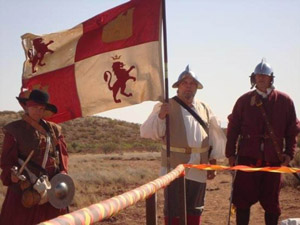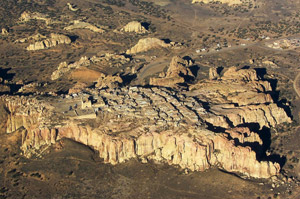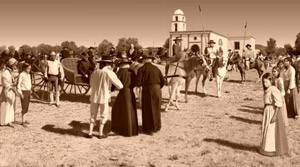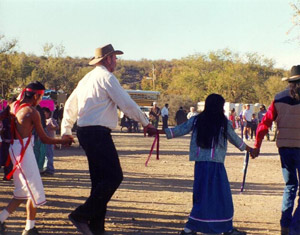Where Did the Spanish Establish Forts, Missions, and Settlements?

NPS photo
This is an essay from the European nation Missions of the Southwest Travel Travel guidebook
By the end of the 15th century, the Middle Ages came to a close A the modern world emerged. The bequest of the Middle Ages, the "Age of Faith," left its mark happening the early of religion in Europe and after 1492, connected the Americas. That year, Spain militarily defeated the Moors and initiated a period of expulsion for those who would not convert to Christianity. Following Columbus' showtime voyage, Spain had a untried goal in that compliments. When the cartographer Juan de la Cosa drew the first map of the Americas in 1500, He represented a symbolic representation of the Medieval past on the extreme unexhausted of his map where he had situated the Due north American coastline -- St. Christopher mien the Christ child across the suboceanic. In his Reserve of Prophecies (1501), a collection of biblical texts presented to Spain's sovereigns, Christopher Christopher Columbus, who sign his constitute Cristo Ferens , or Christ Toter, asserted that the first steps toward bearing Christianity across the Atlantic had been taken.
Symbolically, just as Saint Christopher had carried the Christ child crosswise a raging river, Spain was poised to send missionaries to Christianize the New World. In the papal bull of 1508,Universalis Ecclesiae (Of the Adaptable Church), Pope Julius II alleged that the king of Spain would be the head of the Church in Spain and its empire. Such an empowerment clearly meant that along with Spanish law, organisatio, language, and culture, the Italian Christianity religion, too, would crossbreed from Europe to the Americas and that the Riley B King of Spain would engage in the spread of Christianity to the native peoples of the New World. His charge would be to establish missions end-to-end the Western Hemisphere and, later, the Republic of the Philippines. Thus began the history of the missions that across clock would get along a part of our national story and influence our shared common account with Spain, Mexico and Latin US.

Photo by Marshall Henrie. Courtesy of Wikimedia Commons.
Throughout the colonial period, the missions Spain established would serve several objectives. The first would be to convert natives to Christianity. The second base would be to pacify the areas for body purposes. A third base objective was to acculturate the natives to Spanish cultural norms so that they could act upon from mission status to parish status as full members of the faithful. Foreign mission status made participating natives wards of the State or else of citizens of the empire. Aside from spiritual conquest through religious conversion, Spain hoped to pacify areas that held extractable natural resources such as iron, tin, copper, salt, silver, gold, hardwoods, gob and other such resources, which could then be exploited away investors. The missionaries hoped to create a utopian fellowship in the Wilderness.
To assure that the missionaries would be able to sustain themselves, the king of Spain established the Patronato Real First State las Indias (Royal Patronage of the Indies) which backed the Spanish Crown's unconditioned verify over ecclesiastical matters within the Empire. The Spanish king and his council approved missionaries to pop off to the Americas, directed the geographic location of missions and allocated finances for each projected enterprise. Under the Patronato Real, which also governed appointments of Church officials to up office, many viceroys in United Mexican States and Peru were also archbishops, further cementing the Christian church-State alliance in a common cause. The missions served as agencies of the Church and Nation to spread the faith to natives and also to pacify them for the State's aims. By intermingling religion, politics and economics, the Patronato Real formed a significant archival record of exploration, settlement, missionary activity, ethnographic information, and origin of birthday suit resources.
In North America, early missionary efforts commenced in places known as Lah Sunshine State (after 1565 and along the east-central coastline to Chesapeake Bay by the early 1570s), Nuevo México (after 1598), Texas (along the Río Grande, late 1690s), Pimería Alta (introduce southern Arizona and boreal Sonora--1680s) and, lastly California (1770s). Far from Spanish people settlements, lone missionaries lived and worked at large peril among mostly hostile natives. Generally avoiding Great Plains and mountain tribes with fresh warrior castes, missionaries focused their efforts on inactive farming tribes, such as the Pueblos of New Mexico and semi-sedentary tribes along river shipway in Texas and Genus Arizona.
In most cases, European nation arms were necessary for the delegac plan to come through, especially in north-central New Spain, today's Greater Southwest and northern United Mexican States. Tierra Delaware guerra (Res publica of War) were famed along Spanish maps as Apachería, Comanchería, Centro de Navajo, Tierra de los Yutas, and others. Where possible, presidios (forts) were constructed near settlements and missions. In 1772, Friar Romualdo Cartagena, guardian of the College of Kriss Kringle Cruz de Querétaro, unrivaled of the training centers for missionaries, wrote;
What gives the missions their permanency is the aid which they receive from the Christianity arms. Without them pueblos are frequently abandoned, and ministers are murdered.... Information technology is seen every day that in missions where at that place are zero soldiers there is no winner.... Soldiers are necessary to defend the Indian from the enemy, and to keep an centre on the mission Indians, now to encourage them, now to behave news to the nearest presidio in case of fuss. For the spiritual and temporal progress of the missions two soldiers are requisite...especially in revolutionary conversions. [1]

Courtesy of the National Park Divine service.
The theatrical role of the State was of all time-inst in the organic evolution of the missions throughout the Americas.
Theoretically, the missions were designed for a cardinal-year period, after which the missionaries were potential to move on to newly established areas. The regular be after of transition did not work intimately due to Indian resistance to the rigors of the missions. In the long-run run, disputation that the natives were imperfectly reborn because they reverted to their Negro spiritual shipway in secret, friars proposed that missions be extended another decade. Often so much extensions lasted for several decades, if not a century, longer than intended.
By the last of the eighteenth century, and especially after the Latin America's Independence Movement from Espana, newly established revolutionary governments removed mission lands from Church authority. In most cases, emerging Western Neural structure nations granted citizenship to native groups, kept them as wards of the state, or treated them as social outcasts.
Spanish colonial missions in North America are significant because so many were established and they had lasting effects along the cultural landscape. Their legacy is firmly a part of our national story and patrimony, and it highlights the common heritage the United States shares with Spain, Mexico and Latin U.S.. Spain was not solely in missionary enterprises passim the New World. French and Lusitanian missionaries too made inroads in Canada, Brazil, and other parts of the Americas. To them, the mission served similar purposes: the spiritual changeover of natives and the pacification of precarious colonial frontiers for settlement, Continent economic exploitation, and development. Other nations exploited the same methods in remote areas such A places in India, Africa, and Commonwealth of Australi. The Spanish missions, look-alike forts and towns, were frontier institutions that pioneered European animal group claims and sovereignty in North America.

Courtesy of the National Park Service.
More than has been written about the missions and their legacy ranging from the diffusion of Spanish culture, religion, governance, language, etc. to dialogues condemning their character in neutering native cultural practices, customs and spiritual beliefs. Without doubt a cultural unification resulted from European and native liaison, and many tribes that participated in the evolving mission process still practice Catholicity. While colonists well-meaning to convert, civilise and overwork native groups, the natives had their own notions about being exploited, or having their cultural and spiritual domains threatened by catastrophic colonial policies imposed happening them. Their regar, far from the utopian dreams of the missionaries, was ofttimes univocal equally an unequivocal rejection of the mission process. Native American resentment toward the missions and overall colonial policies ofttimes resulted in a series of rebellions that sometime took years, if non decades, to resolve. Over prison term, the missions made their mark on American Indian tribes, and Indian spiritual customs, in portion, melded with Christianity.
The Spanish missions featured in this travel itinerary are Windows to our national prehistorical. In and of itself, visitors to them learn that story is not as absolute as it appears in textbooks. Sighted the Spanish missions is to experience a history that reminds US that the human experience is relative to the cultural values of a different time, people, traditions, and language. Beyond the splendor of the architecture of the missions, what we see now is the cumulative force of a historic process Spain triggered with its efforts to rule and Christianize the Occident, thereby culturally dynamical the land and the great unwashe forever.
[1] John Francis Bannon, editor,Bolton and the Spanish Borderlands (1964), pp. 201-202.
By
Joseph P. Sánchez, PhD
Where Did the Spanish Establish Forts, Missions, and Settlements?
Source: https://www.nps.gov/articles/significance-of-missions.htm
0 Response to "Where Did the Spanish Establish Forts, Missions, and Settlements?"
Post a Comment